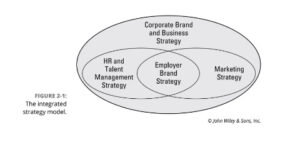The Employer Branding Handbook: Menciptakan Reputasi Positif dan Tim Berkinerja Tinggi
Employer Branding telah menjadi aspek manajemen SDM yang semakin penting, karena perusahaan bersaing untuk menarik dan mempertahankan talenta terbaik di pasar kerja yang sangat kompetitif. Employer Branding yang kuat dapat membantu membedakan perusahaan Anda dari pesaing, menarik kandidat yang tepat, dan menciptakan budaya tempat kerja yang positif. Pada artikel ini, kami akan mengeksplorasi strategi untuk membangun merek pemberi kerja yang kuat berdasarkan penelitian dan saran praktis dari para ahli di bidangnya.
Defining Your Employer Brand
Langkah pertama dalam membangun Employer Branding yang kuat adalah menentukan apa yang membuat perusahaan Anda unik. Ini melibatkan pemahaman budaya, nilai, dan misi perusahaan Anda, dan bagaimana ini sejalan dengan kebutuhan dan harapan audiens target Anda. Menurut Richard Mosley, penulis “Employer Branding for Dummies” dan “Employer Branding and the Employee Lifecycle,” Brand’s Image Strategy harus didasarkan pada tiga elemen utama: diferensiasi, relevansi, dan keaslian.
Untuk membedakan perusahaan Anda dari pesaing, Anda perlu mengidentifikasi apa yang membuat perusahaan Anda unik dan unggul dalam bidang tertentu dalam Employer Branding ditempat Anda. Misalnya, jika perusahaan Anda memiliki komitmen yang kuat terhadap keberlanjutan, Anda dapat meng-highlight nilai tersebut dalam strategi rekrutmen ditempat Anda untuk menarik kandidat yang memiliki nilai yang sama.
Relevansi berarti memahami kebutuhan dan preferensi audiens target Anda dan membentuk Employer Branding ditempat Anda untuk memenuhi kebutuhan ini. Misalnya, jika Anda menargetkan kaum milenial, Anda mungkin dapat memfokuskan pada nilai Work Life Balance, waktu kerja yang fleksibel, dan kesetaraan peluang untuk tumbuh dan pengembangan karier.
Authenticity berarti memiliki loyalitas dan menerapkan budaya, nilai, dan misi perusahaan Anda. Ini berarti tidak hanya mempromosikan aspek-aspek positif perusahaan Anda, tetapi juga bersikap transparan tentang tantangan atau bidang apa pun untuk perbaikan. Ini membantu membangun kepercayaan dengan kandidat potensial dan menciptakan reputasi positif untuk perusahaan Anda.
Leveraging Your Existing Employees
Salah satu sumber daya paling powerful untuk membangun Employer Branding yang kuat adalah karyawan Anda yang ada saat ini. Menurut Laura K. Meister dan Kelly Monahan, penulis buku “The role of employer branding in the war for talent,” karyawan dapat menjadi “brand ambassador” yang membantu mempromosikan budaya dan nilai perusahaan Anda melalui media sosial dan media lainnya.
Untuk memanfaatkan karyawan Anda, Anda dapat mendorong mereka untuk membagikan pengalaman dan kisah sukses mereka di platform media sosial seperti LinkedIn, Instagram, dan Facebook. Anda juga dapat memberi mereka peluang pelatihan dan pengembangan yang membantu mereka tumbuh secara profesional dan menjadi lebih terlibat dengan perusahaan Anda.
Building a Strong Online Presence
Di era digital saat ini, kehadiran media online yang kuat sangat penting untuk membangun brand perusahaan yang kuat. Ini berarti memiliki situs web perusahaan yang dirancang dengan baik dan informatif, serta profil media sosial aktif yang menampilkan budaya, nilai, dan misi perusahaan Anda.
Untuk membangun brand image online yang kuat, Anda harus berfokus pada pembuatan konten yang menarik, informatif, dan relevan dengan audiens target Anda. Ini dapat mencakup posting blog, video, dan pembaruan media sosial yang menyoroti kualitas dan nilai unik perusahaan Anda. Anda juga harus terlibat dengan pengikut Anda dan segera menanggapi komentar dan pertanyaan mereka untuk membangun reputasi positif bagi perusahaan Anda.
Investing in Employee Development
Berinvestasi dalam pengembangan karyawan adalah strategi kunci lain untuk membangun Employer Branding yang kuat. Ini berarti memberi karyawan Anda peluang pelatihan dan pengembangan yang membantu mereka mempelajari keterampilan baru, menghadapi tantangan baru, dan tumbuh secara profesional.
Menurut Rachel I. Richardson dan J. Scott Armstrong, penulis “Building a Strong Employer Brand: A Case Study of the University of Warwick,” berinvestasi dalam pengembangan karyawan dapat membantu mempertahankan karyawan yang ada dan menarik bakat baru yang ingin bekerja untuk mereka. sebuah perusahaan yang menghargai pertumbuhan profesional mereka.
Creating a Positive Candidate Experience
Terakhir, menciptakan pengalaman kandidat yang positif sangat penting untuk membangun Employer Branding yang kuat. Ini berarti memberikan komunikasi yang jelas, proses rekrutmen yang tepat waktu dan efisien, serta kesan positif tentang budaya dan nilai perusahaan Anda selama proses rekrutmen.
Menurut sebuah studi oleh CareerArc, 60% pencari kerja memiliki pengalaman kandidat yang buruk, dan ini dapat berdampak negatif pada merek perusahaan Anda. Untuk menciptakan pengalaman kandidat yang positif, Anda harus:
Berkomunikasi dengan jelas dan segera dengan kandidat selama proses rekrutmen, termasuk memberikan pembaruan rutin tentang status lamaran mereka. Bersikap hormat dan profesional dalam semua interaksi dengan kandidat, termasuk selama wawancara dan komunikasi lanjutan. Berikan review yang realistis tentang budaya dan nilai perusahaan Anda selama proses rekrutmen, termasuk melalui deskripsi pekerjaan, testimonial karyawan, dan kunjungan lapangan jika memungkinkan. Dengan menciptakan pengalaman kandidat yang positif, Anda dapat membantu menarik talenta terbaik dan membangun reputasi positif untuk perusahaan Anda.
The Importance of Employer Branding
Menurut sebuah studi oleh LinkedIn, perusahaan dengan Employer Branding yang kuat memiliki biaya per perekrutan 43% lebih rendah dan tingkat turnover 28% lebih rendah dibandingkan dengan perusahaan dengan Employer Branding yang lemah. Hal ini menunjukkan bahwa berinvestasi dalam Employer Branding dapat memberikan manfaat yang signifikan bagi organisasi dalam hal akuisisi dan retensi talenta.
Selain itu, dalam sebuah studi oleh Universum, 90% pelajar dan profesional muda mengatakan bahwa mereka akan mempertimbangkan Employer Branding sebelum melamar pekerjaan. Ini menyoroti pentingnya Employer Branding dalam menarik generasi talenta berikutnya. Google telah diakui sebagai salah satu pemberi kerja paling menarik secara global karena lingkungan kerjanya yang unik dan ramah karyawan.
Google’s Employer Brand
Perusahaan secara konsisten berinvestasdalam branding pemberi kerja untuk menarik dan mempertahankan talenta terbaik. Chief of Development Employer Strategy di Google adalah Kyle Ewing. Ewing telah bergabung dengan Google sejak 2007 dan telah memegang berbagai peran kepemimpinan SDM, termasuk memimpin SDM untuk organisasi penjualan dan memimpin mobilitas dan imigrasi global. Dalam perannya saat ini, Ewing bertanggung jawab untuk mendorong strategi merek perusahaan global Google dan inisiatif keterlibatan karyawan.
Google dikenal dengan lingkungan kerjanya yang inovatif dan ramah karyawan. Merek pemberi kerja perusahaan berfokus pada mempromosikan nilai-nilai kreativitas, kolaborasi, dan pembelajaran berkelanjutan.
Strategi komunikasi Google mencakup situs webnya, saluran media sosial, dan berbagai acara serta inisiatif yang mempromosikan merek perusahaannya. Perusahaan juga melibatkan karyawannya dalam proses branding dengan mendorong mereka untuk berbagi pengalaman melalui media sosial dan saluran komunikasi internal.
Google mengukur keefektifan merek perusahaannya melalui berbagai metrik, termasuk retensi karyawan dan tingkat kepuasan. Retensi karyawan mengacu pada persentase karyawan yang tetap bersama perusahaan selama periode tertentu. Tingkat retensi yang tinggi menunjukkan bahwa karyawan puas dengan pekerjaan mereka dan lingkungan kerja perusahaan. Google menggunakan tingkat retensi karyawan sebagai ukuran keefektifan merek pemberi kerjanya karena ini menunjukkan seberapa baik perusahaan mampu menarik dan mempertahankan talenta terbaik.
Tingkat kepuasan karyawan, di sisi lain, mengacu pada persentase karyawan yang melaporkan puas dengan pekerjaan dan perusahaan mereka. Google secara rutin melakukan survei karyawan untuk mengukur tingkat kepuasan karyawan. Perusahaan juga melacak umpan balik karyawan melalui berbagai saluran seperti ulasan Glassdoor, survei keterlibatan karyawan, dan pertemuan empat mata. Google juga mengukur keefektifan merek perusahaannya melalui metrik lain seperti:
- Applicant tracking: Google melacak jumlah pelamar pekerjaan yang diterimanya dan kualitasnya untuk mengukur keefektifan merek perusahaannya dalam menarik talenta terbaik.
- Social media engagement: Google mengukur tingkat keterlibatan di saluran media sosialnya, seperti suka, bagikan, dan komentar, untuk mengukur keefektifan pesan merek perusahaannya.Brand recognition: Google mengukur tingkat pengenalan merek yang dimilikinya di antara pencari kerja untuk menilai keefektifan strategi merek perusahaannya.
Contoh: Pada tahun 2020, Google menduduki peringkat nomor satu dalam daftar Perusahaan Terbaik Fortune untuk Bekerja. Pemeringkatan ini didasarkan pada beberapa faktor, antara lain kepuasan karyawan, tingkat retensi, dan tunjangan yang ditawarkan. Peringkat tinggi Google adalah contoh bagaimana strategi branding perusahaan telah efektif dalam menarik dan mempertahankan talenta terbaik. Selain itu, tingkat retensi perusahaan yang tinggi dan umpan balik karyawan yang positif pada platform seperti Glassdoor merupakan indikator efektivitas strategi merek perusahaan Google. Perusahaan secara teratur memperbarui merek perusahaannya untuk memastikannya tetap relevan dan efektif
Strategi branding perusahaan Google mencakup hal-hal berikut:
- Promoting its values: Strategi branding perusahaan Google berfokus pada mempromosikan nilai-nilai inovasi, kolaborasi, dan pembelajaran berkelanjutannya. Perusahaan menunjukkan komitmennya terhadap nilai-nilai ini melalui lingkungan kerja, tunjangan karyawan, dan inisiatif tanggung jawab sosial perusahaan.
- Providing an exceptional work environment: Google menyediakan lingkungan kerja yang menyenangkan, suportif, dan kreatif bagi karyawannya. Kampus perusahaan dirancang untuk mendorong kolaborasi dan kreativitas, dan karyawan diberikan berbagai fasilitas seperti makanan gratis, pusat kebugaran, dan perawatan kesehatan di tempat.
- Encouraging employee empowerment: Google memberdayakan karyawannya untuk memiliki pekerjaan mereka dan memberi mereka kebebasan untuk mengejar hasrat mereka. Perusahaan mendorong karyawannya untuk beikir kreatif dan memberi mereka berbagai peluang untuk pertumbuhan pribadi dan profesional.
- Engaging with the community: Google secara aktif terlibat dengan komunitas melalui berbagai prakarsa tanggung jawab sosial perusahaannya. Perusahaan mempromosikan kelestarian lingkungan, keadilan sosial, dan pendidikan, di antara penyebab lainnya.
Kesimpulan
Membangun Employer Branding yang kuat sangat penting untuk menarik dan mempertahankan talenta terbaik di pasar kerja yang sangat kompetitif saat ini. Dengan mendefinisikan merek perusahaan Anda, memanfaatkan karyawan Anda yang ada, membangun kehadiran online yang kuat, berinvestasi dalam pengembangan karyawan, dan menciptakan pengalaman kandidat yang positif, Anda dapat membedakan perusahaan Anda dari pesaing dan menciptakan budaya tempat kerja yang positif yang menarik dan mempertahankan talenta terbaik.
Referensi:
Ambler, T., & Barrow, S. (1996). The employer brand. Journal of Brand Management, 4(3), 185-206.
Iles, P., & Yolles, M. (2010). Employer branding and the contemporary career. Journal of Brand Management, 18(2), 93-101.
Klienman, M., & McDonald, S. (2017). Employer branding and talent management in the luxury sector. Journal of Business Research, 70, 357-365.
Meister, L. K., & Monahan, K. (2014). The role of employer branding in the war for talent. Journal of Brand Strategy, 3(1), 20-30.
Mosley, R. (2017). Employer Branding and the Employee Lifecycle. Wiley.
Mosley, R. (2017). Employer Branding for Dummies. Wiley.
Richardson, R. I., & Armstrong, J. S. (2018). Building a strong employer brand: A case study of the University of Warwick. International Journal of Forecasting, 34(4), 820-827.



